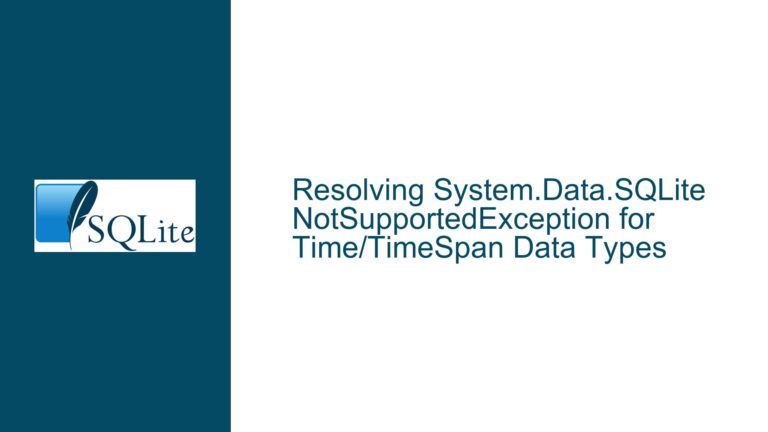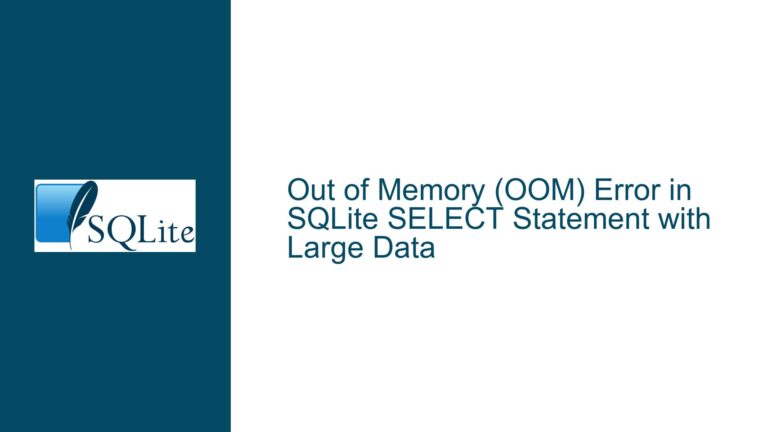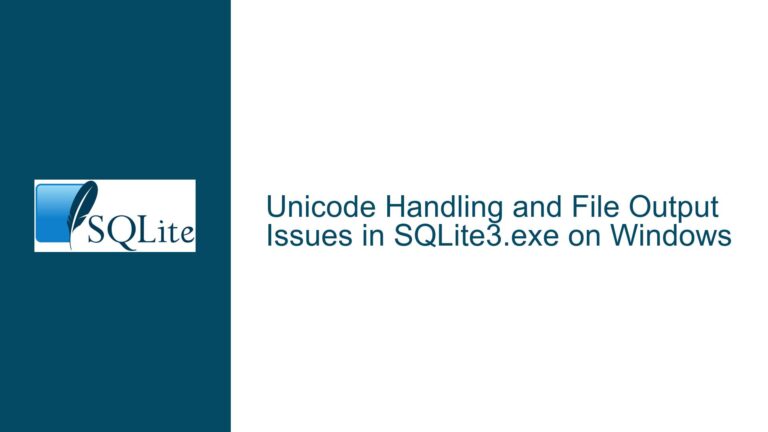WASM Build Limitations in SQLite: Multithreading and Concurrent Access Challenges
Understanding the WASM Build’s Single-Threaded Nature in SQLite
The SQLite WASM build is inherently single-threaded due to the compilation flag -DSQLITE_THREADSAFE=0, which disables thread safety. This design choice is rooted in the limitations of JavaScript (JS) and WebAssembly (WASM) execution models, particularly in browser environments. The primary issue revolves around the inability to create a database handle (sqlite3*) that can be accessed concurrently by multiple threads. This limitation is not specific to SQLite but is a consequence of how JS and WASM handle threading and memory sharing.
In JS, each thread operates in its own sandboxed environment, meaning that objects created in one thread cannot be directly accessed or manipulated by another thread. This isolation extends to WASM modules, where each thread must load its own independent copy of the WASM module and associated JS code. As a result, even if multiple threads are spawned using Web Workers, each thread must maintain its own separate database connection, leading to significant memory overhead and inefficiencies.
The current WASM build of SQLite is optimized for single-threaded use cases, which are common in browser-based applications. However, this design poses challenges for developers who require concurrent access to a SQLite database, as the JS execution model does not support true multithreading. While there are experimental features like SharedArrayBuffer and WebAssembly threads that aim to address these limitations, they are not yet standardized or widely supported across all platforms.
Exploring the Constraints of JS and WASM for Concurrent Database Access
The constraints of JS and WASM for concurrent database access stem from the fundamental differences between how C and JS handle threading and memory management. In C, threads can share memory and resources, allowing multiple threads to access the same database handle concurrently. In contrast, JS threads (Web Workers) are isolated from each other, with no direct way to share memory or objects. This isolation prevents the creation of a shared database handle that can be accessed by multiple threads.
One potential workaround is to use SharedArrayBuffer and the Atomics API to facilitate communication between threads. However, this approach requires serializing and deserializing data, which introduces significant overhead and complexity. Additionally, the SharedArrayBuffer is not universally supported, particularly on devices like the Raspberry Pi, further limiting its applicability.
Another approach is to use postMessage() to send messages between threads. While this method allows for communication between threads, it does not provide true concurrency. The database connection remains tied to a single thread, and all queries must be processed sequentially within that thread. This limitation makes it impossible to achieve true parallel execution of database queries, even if multiple threads are used to submit queries.
The current implementation of SQLite in WASM also lacks support for interrupting long-running queries, as the JS execution model does not allow for preemptive multitasking. This means that once a query starts executing, it cannot be interrupted until it completes, further limiting the responsiveness of the database in a multithreaded environment.
Strategies for Managing Transactions and Concurrency in SQLite WASM
Managing transactions and concurrency in SQLite WASM requires careful consideration of the asynchronous nature of JS and the limitations of the WASM build. One of the primary challenges is ensuring that transactions are executed atomically, without interference from other code that might attempt to start a new transaction in the middle of an existing one.
In a typical JS environment, database operations are performed asynchronously, meaning that control is yielded back to the event loop after each operation. This behavior creates opportunities for other code to execute between database operations, potentially leading to conflicts such as attempting to start a new transaction while another transaction is still in progress.
To address this issue, developers can use techniques such as wrapping transaction-related code in a single callback function. This approach ensures that all operations within the transaction are executed sequentially, without yielding control back to the event loop. For example, the SQLite OO API provides methods like transaction() and savepoint(), which take a callback function and execute it within the context of a transaction. If the callback function throws an error, the transaction is rolled back; otherwise, it is committed.
Another strategy is to use a single worker thread to manage all database operations, ensuring that only one transaction is active at any given time. This approach eliminates the risk of transaction conflicts but may limit the scalability of the application, as all database operations must be funneled through a single thread.
For more complex scenarios, developers can implement a custom coordination layer that manages the execution of transactions across multiple workers. This layer can use postMessage() to communicate with workers and ensure that transactions are executed in the correct order. However, this approach introduces additional complexity and overhead, as it requires careful management of message queues and worker states.
In conclusion, while the SQLite WASM build offers a powerful tool for embedding a database in browser-based applications, it comes with significant limitations when it comes to multithreading and concurrent access. Developers must carefully consider these constraints and adopt strategies that align with the capabilities of the JS and WASM execution models. By understanding the underlying issues and leveraging appropriate techniques, it is possible to build robust and efficient applications that make the most of SQLite in a WASM environment.






